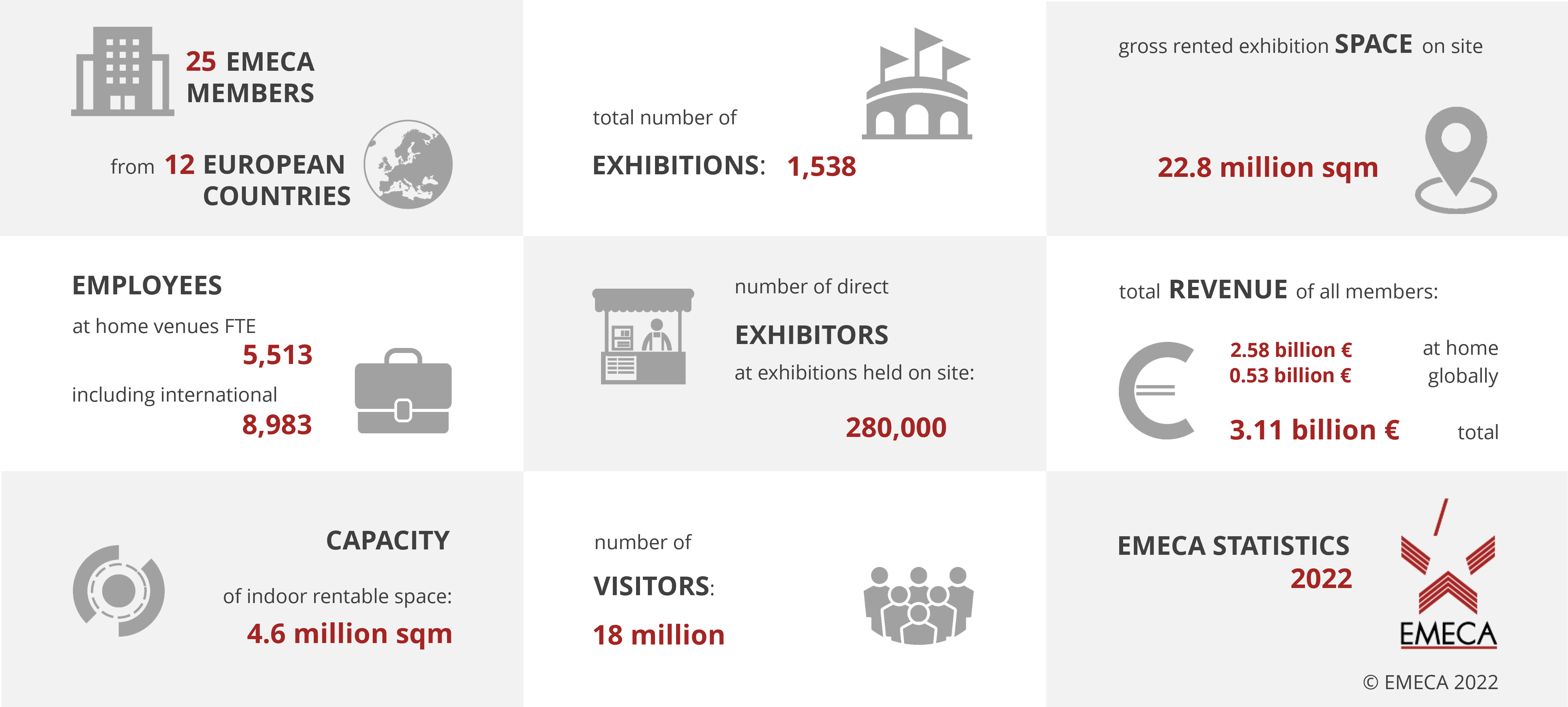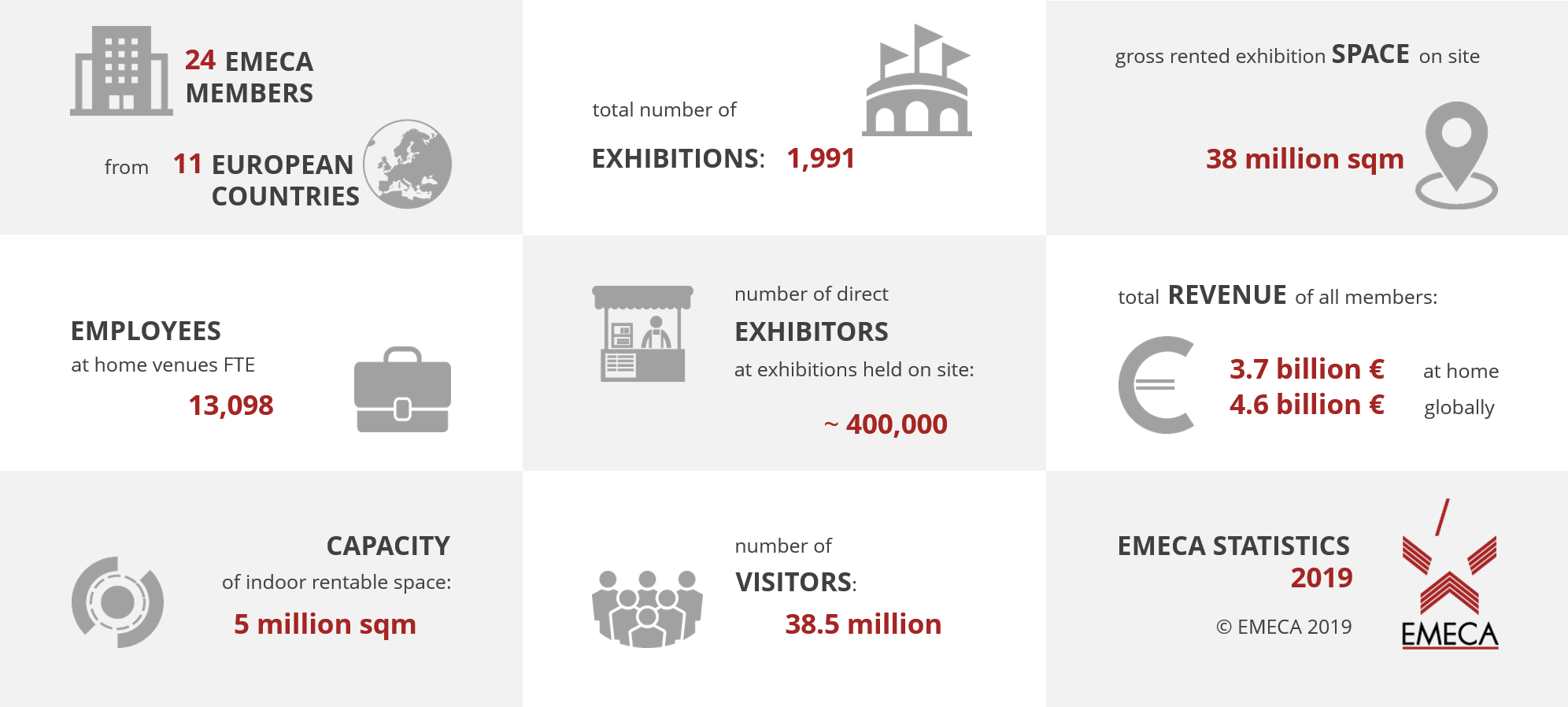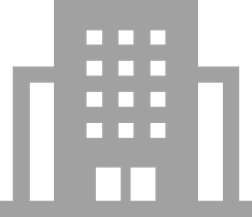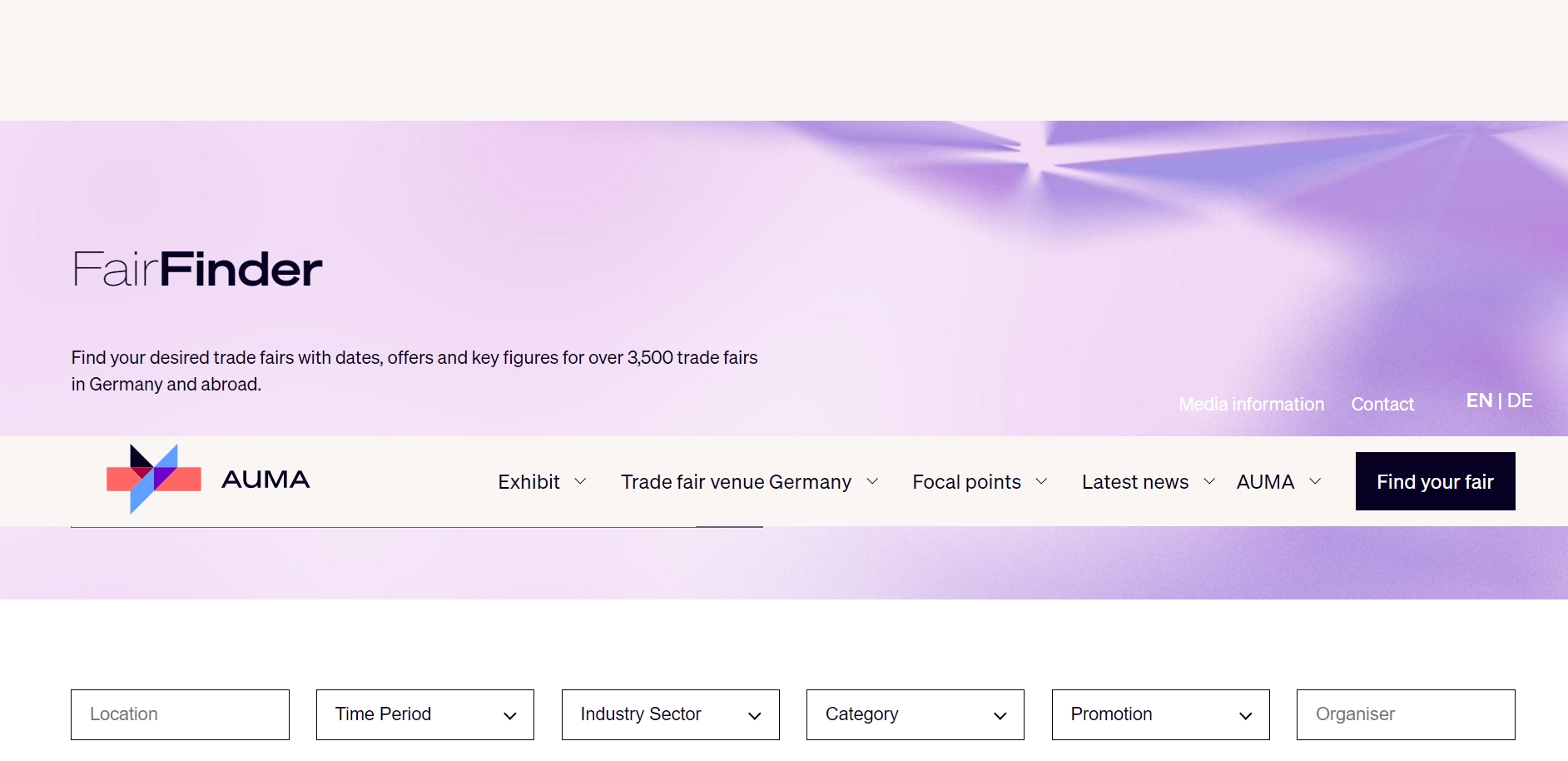EMECA STATISTICS 2022

EMECA STATISTICS 2019

STUDIES
EMECA EXHIBITION VENUES – SAFE AND HEALTHY PLACES FOR EXHIBITIONS
All EMECA exhibition venues have proactively developed advanced health and safety protocols that take into account the respective Covid-19 situation and are based on WHO and on national as well as local health guidelines. And they have established a comprehensive EMECA database for the best measures, practices and technologies.
ECONOMIC IMPACT – POWER OF THE EXHIBITION INDUSTRY
The 22 (2016) large and leading trade fair venues in Europe united in the Major European Exhibition Centres Association (EMECA) generate a significant socio-economic impact for the immediate surroundings of a venue, for the wider region and on national or transnational level. A new impact study conducted by KPMG on behalf of EMECA reveals the economic power of the exhibition industry in Europe and of EMECA Members’ venues in particular.
EMECA impact of EUR 120,638 million out of EUR 303,052 million for Europe
Based on data for 2016, the socio-economic effect generated by the 22 EMECA Members amounts to EUR 120,638 million, the equivalent of 50% of the GDP of a country like Finland. The total impact of the exhibition industry for geographical Europe is EUR 303,052 million which equals roughly the GDP of Denmark.
“The effect created by EMECA Members’ alone represents 40% of the total socio-economic impact calculated for the exhibition industry in Europe. This is a fantastic result and confirms the leadership of the exhibition venues affiliated with EMECA”, says Claude Membrez, EMECA President and CEO of Palexpo Geneva.
The exhibition industry in Europe: capacity, quality and multiplier effect
Europe is the most significant region for the exhibition industry worldwide in terms of exhibition quality and capacity. 38 out of 62 venues that are larger than 100.000 sqm are located in Europe. EMECA Members operate 8% (39 sites) of the European exhibition premises and offer 30% (4.7 mio sqm) of the total exhibition space available in Europe. Regarding the quality of venues and exhibitions, exhibitors and visitors grant European venues the highest quality rankings, proving that these venues successfully render outstanding business and leisure environments.
The 22 EMECA Members’ have an impressive productivity: it would rank second with a multiplier effect of 2,22 after the Chemical Industry in Europe (2,7), the sector with the biggest output multiplier according to Eurostat, and before the Construction Industry (2,16).

Methodology and division of results
The socio-economic effects are calculated in three different layers: 1. Direct effects include tax contribution, direct purchases and employment by EMECA Members’ venues as well as exhibitors’ and visitors direct spending; 2. Indirect impact created by employees consumption and economic activity generated by the first and second tier of the supply chain; and 3. Induced Impact referring to the economic impact and employment effects on other sectors due to growing demand in the rest of the supply chain.
Of the total effect of EUR 120,638 million, EUR 101,445 million are due to the pull effect, deriving from purchase from suppliers, investments, salaries, and expenses of the exhibitors and visitors associated with the exhibitions. According to the calculation methodology used, the effect on employment would amount to 495,287 jobs. The total contribution to the public budget is estimated at EUR 19,193 million. Over 97% of this amount stem from the value added tax linked to the impacts.
Exhibitors and visitors
Exhibitors and visitors to exhibitions held on EMECA Members’ premises generate a total of EUR 59,295 million and 330,368 jobs, which represents nearly half of the total impact. The main expenses of exhibitors are related to the activity at the exhibition venue itself. Exhibition fees and in-event expenditure alone represent roughly 40% of the total exhibitors’ expense. As for visitors, their expenditure is highest on accommodation followed by transport and restaurants. On average, 90% of the visitors’ expenditure is generated by international visitors. This means that a national visitor generates economic effects of EUR 96 while each international visitor contributes EUR 4,441 to the economy.
Impact on sectors of the economy
Four sectors benefit most from the exhibition activity, absorbing 87% of the impact in terms of wealth creation and 80% in terms of employment generation: 1. Support services activities, including hotels, restaurants, wholesale and retail, repairs, IT and more; 2. Energy; 3. Manufacturing and 4. Transportation of goods and people, storage, postal services. It means for example that 233,419 jobs are created and sustained in the support services industry and 107,117 employments in the transportation sector. Investments and purchases by the exhibition venues themselves benefit mostly the construction sector, as these investments pertain particularly to upgrading the venues and expanding their capacity. The support services sector generates the greatest pull effect through purchases from suppliers, since this category includes key activities of the exhibition venues such as maintenance of facilities, trade or hospitality.
ENERGY EFFICIENCY OF MAJOR EUROPEAN EXHIBITION CENTRES
Operating exhibition venues with outside and inside space requires exact handling of energy in order to achieve an optimal climate for different types of trade fairs under different weather conditions. Further to the general aim of operating exhibition venues in a responsible and ressource-efficient way, the energetic performance of an exhibition venue may have a significant influence on the economic performance of the exhibition venue operators. Emeca Members continuously invest important sums into their infrastructure to offer highest quality venues to their customers.
With the aim to obtain general recommendations as to construction, refurbishment and operation, EMECA conducted a study on the Energy Efficiency of exemplary exhibition halls at their Members' venues. The initiative measured the properties and energy consumption of representative fair and exhibition venues in Europe. The main focus was the relationship between construction materials and facade techniques and the energy consumption for space heating and cooling. The exhibition centres selected for the study include the newer facilities in Milan (2005) and Stuttgart (2007) and the older exhibition centres in Madrid (1991) and Utrecht (1916). The background to the study is the complex building structure of the European exhibition centres, which according to an initial survey of the 18 EMECA members offered considerable development potential in terms of energy savings.
The idea of the study was developed by the EMECA Technical Working Group set up under the direction of Veronafiere in 2009. It was conducted by the Polytechnic University of Milan.
ACCESSIBILITY OF EMECA EXHIBITION SITES
In view of the “European Year of Equal Opportunities for All” in 2007, EMECA commissioned an infrastructure study on accessibility at big European exhibition venues. The study was prepared by the Technical University of Milan and the University of Brescia, renowned in engineering, urban planning, architecture and design.
It sheds light on the following research goals:
- Guaranteeing access to vulnerable users, thereby improving accessibility for all users
- Pursuing and enhancing the autonomy of individual users in visiting trade fairs
- Improving visitors’ reception, comfort and safety
- Enhancing the continuity in the connection between the trade fair’s collective space and the public spaces in the urban fabric
- Allowing for good access to fairs from urban public and international transport systems
Read our brochure "Ease of access - Ease of success"
AUMA, the Association of the German Trade Fair Industry provides an exhibition database containing information about all the dates, services and key figures for more than 5,000 exhibitions worldwide. Find the exhibition at www.auma.de



